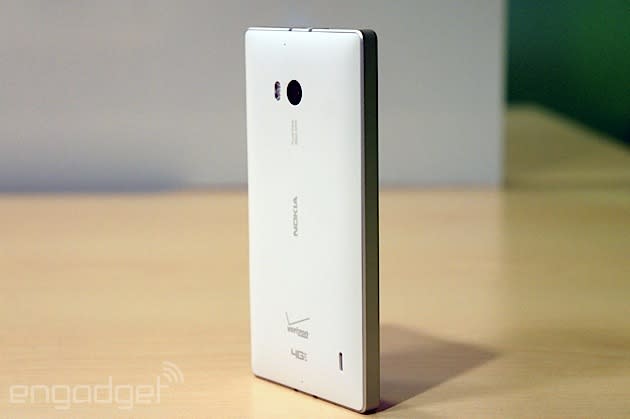Nokia Lumia Icon coming to Verizon February 20th for $200 (hands-on)

Yes, Windows Phones are finally keeping up with the Joneses. Thanks to the latest update, smartphones running Microsoft's mobile OS can now have top-of-the-line components. We got a good taste of how this feels with the Nokia Lumia 1520 (spoiler: It's pretty dang good), but most people would prefer flagship specs in a smaller phone. Enter the Lumia Icon, a loaded 5-inch WP8 device exclusive to Verizon that goes on sale in black and white colors February 20th for $200 with a two-year contract. (It'll cost $550 at full retail or Edge pricing.)
The Icon comes with nearly all the same specs as the Lumia 1520: a 1080p display, 2.2GHz Qualcomm Snapdragon 800 processor, 20-megapixel PureView rear camera (with optical image stabilization, a 1.2MP front-facing webcam, a Gorilla Glass 3 screen, Qi wireless charging, NFC, dual-band WiFi 802.11a/b/g/n/ac and Bluetooth 4.0 + LE. Unsurprisingly, the 2,420mAh battery is smaller, and we hope it can efficiently manage the high-def screen and quad-core processor without a huge drain to the battery.
Aside from the battery and smaller screen, the Icon is an exclusive to Verizon, as evidenced by the three carrier-specific logos on the front and back. And while we wouldn't be surprised to see a 5-inch 1080p Lumia device hit the rest of the market at some point, it probably won't look like the Icon. The phone sports straight aluminum sides and a curved back fashioned out of matte polycarbonate. In many ways, the setup reminds us of the Lumia 925, which features rounded metal sides and the same plastic back; the Icon is 0.5mm thicker, but it also doesn't have a distracting camera hump like the 925 has. We'll offer more impressions below, but not before showing off a gallery of images and a brief walk-through video.
Before we go any further, it's important to acknowledge the display -- the first 5-inch 1080p ClearBlack panel to show up in a Windows Phone. Nokia opted for an OLED screen instead of LCD this time around -- the 1520 features the latter, while the 1020 and 925 use the former -- and it boasts a pixel density of 441 pixels per inch. In addition to a sharp picture, it brings fantastic viewing angles, 500 nits max brightness and an incredibly low-glare screen (similar to what we saw on Nokia's Lumia 2520 tablet). While the Lumia 1520 screen was beautiful, we found ourselves champing at the bit to play with a similar HD display in a smaller size -- and we were impressed as soon as we saw it.
Another aspect of the Icon worth mentioning is its four-microphone setup for directional audio. The Lumia 1520 had this as well, but it's great to see it becoming a standard on Nokia's latest devices. With a pair of mics in the back and another pair in the front, it allows you to hear audio from the situation in front of you while filtering out the extra noise going on in the background. And speaking of audio, the external rear speaker is placed near the bottom end, right where the flattest part of the back begins to slope gradually to the edges; Nokia assures us that audio won't sound muffled because the back is curved, however, so we'll have to save our conclusion for the official review in a few days.

When viewing the front or back of the Icon straight-on, you'll notice that the metal sides ring around the perimeter, which we presume serve as protection from most impacts. Those same sides are also connected to the back by a small chamfer. The top and bottom edges are nearly symmetric: The bottom features a centered micro-USB fast-charge 2.0 port and you'll find a 3.5mm headphone jack in the same spot up top (though there's a metallic tray for your nano-SIM just to the left, which throws off the symmetry a bit), and each port is flanked by the phone's gray antennas.
It's a solid device with good materials, to be sure, but there are a couple things to watch out for. Since the metal plays a prominent role in the phone's design, you probably won't last a full two years without at least a few minor dings and scratches on the side (if not much worse) -- if you've used the iPhone for an extensive period of time, you may already know what we're talking about. Additionally, if you don't typically like blocky phones, the Icon won't appeal to you -- it's essentially a thinnish block with a little bubble in the back. On the flip side, it's easy to hold and you won't ever feel like it's going to slip out of your hands, but it's certainly something worth noting.
We'll have a full review ready for you in just a few days, so stay tuned.












































